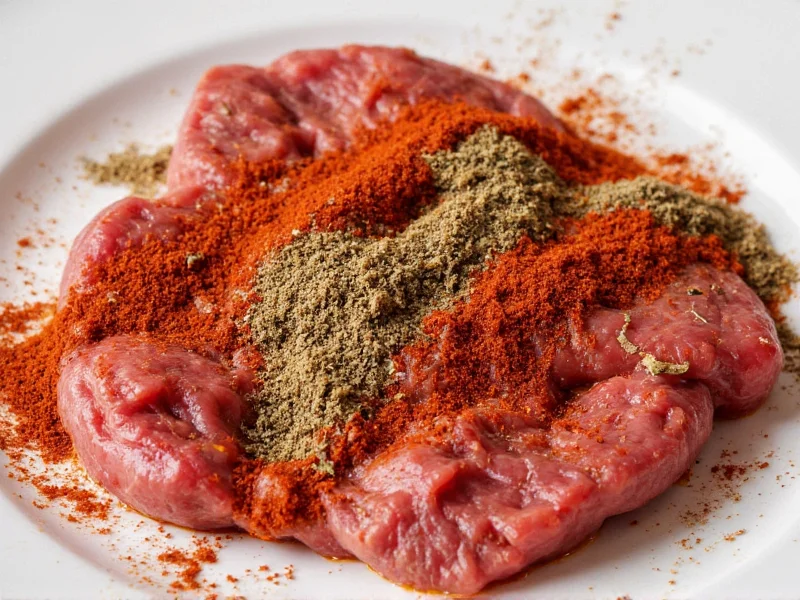Understanding which spices work best with beef transforms ordinary dishes into extraordinary culinary experiences. The science behind successful spice pairings lies in how volatile compounds interact with beef's fat molecules and amino acids during cooking. When selecting spices for beef recipes, consider both traditional combinations and innovative approaches that respect the meat's inherent flavor profile while adding complexity.
The Science of Spice and Beef Pairing
Beef contains high levels of glutamates and inosinates that create umami, the fifth taste sensation. Spices containing sulfur compounds (like garlic and onion powder) or terpenes (found in rosemary and thyme) chemically interact with these compounds, enhancing savory depth. The fat content in beef acts as a carrier for fat-soluble flavor compounds in spices, making proper fat rendering crucial for flavor development.
When applying spices to beef, timing matters significantly. Whole spices benefit from dry roasting before grinding to release essential oils, while delicate herbs like parsley should be added at the end of cooking. For dry rubs, allow at least 30 minutes for spices to penetrate the meat's surface before cooking.
Traditional Beef Spice Combinations by Cuisine
Different culinary traditions have developed time-tested spice combinations for beef. These pairings evolved through generations of cooking experience and reflect regional flavor preferences:
| Cuisine | Signature Spice Blend | Best Beef Application |
|---|---|---|
| Mediterranean | Olive oil, rosemary, garlic, thyme | Grilled steaks, roasted cuts |
| Mexican | Chili powder, cumin, oregano, garlic | Carne asada, ground beef dishes |
| French | Herbes de Provence, black pepper, bay leaf | Beef bourguignon, stews |
| Asian | Ginger, star anise, five-spice powder | Braised short ribs, stir-fries |
| American BBQ | Paprika, brown sugar, mustard powder, cayenne | Brisket, ribs, pulled beef |
Modern Innovative Spice Combinations
Contemporary chefs experiment with unexpected spice pairings that complement beef's richness. These innovative combinations work particularly well with high-quality cuts where the beef flavor remains the star:
- Coffee and cocoa powder - Adds bitter notes that contrast beautifully with beef's sweetness, ideal for ribeye and strip steaks
- Coriander and fennel seeds - Provides citrusy notes that cut through richness, perfect for slow-cooked chuck roast
- Smoked paprika and chipotle - Introduces complex smokiness without actual smoking, excellent for indoor cooking
- Sichuan peppercorns - Creates a tingling sensation that heightens other flavors in Wagyu or Kobe beef
Matching Spices to Beef Cuts and Cooking Methods
The best spice combinations vary based on both the beef cut and cooking technique. Understanding these relationships prevents overpowering delicate flavors or under-seasoning robust cuts:
High-heat methods (grilling, pan-searing): Use robust spices that can withstand high temperatures without burning. Black pepper, garlic powder, and smoked paprika work well for steaks. Avoid sugar-based rubs until the final minutes of cooking to prevent charring.
Slow cooking (braising, stewing): Whole spices like bay leaves, peppercorns, and cinnamon sticks release flavor gradually. Add dried herbs early in cooking while delicate fresh herbs go in during the last 30 minutes.
Roasting: Create a paste with olive oil, garlic, and rosemary for prime rib or tenderloin. The oil helps spices adhere and facilitates even flavor distribution.
Practical Application Tips
For optimal results when seasoning beef, follow these evidence-based techniques:
- Pat beef completely dry before applying spices to ensure proper adhesion
- Season at least 45 minutes before cooking to allow flavor penetration
- Use coarse salt rather than fine for better distribution and controlled salting
- Balance flavors using the principle of contrast: pair rich beef with acidic or bright spice elements
- When creating custom blends, maintain a 3:1 ratio of primary to secondary spices
Avoid common mistakes like over-seasoning with salt (beef already contains natural sodium), using pre-ground spices that have lost potency, or applying delicate herbs too early in the cooking process. Remember that spice preferences vary by region and personal taste, so adjust combinations to suit your palate while respecting the fundamental chemistry of flavor pairing.
Creating Your Own Signature Beef Spice Blend
Developing personalized spice combinations allows you to tailor flavors to your specific preferences. Start with this basic framework for creating balanced beef rubs:
- Choose one primary spice (40% of blend) - typically black pepper, paprika, or cumin
- Select two supporting spices (30% each) - such as garlic powder with thyme or coriander with mustard seed
- Add a flavor enhancer (5-10%) - like celery seed, cocoa powder, or dried mushroom powder
- Incorporate salt separately based on personal preference
Test small batches on inexpensive cuts before using on premium steaks. Keep detailed notes about proportions and results to refine your perfect blend. The ideal beef spice combination should enhance, not mask, the natural flavor of quality beef.











 浙公网安备
33010002000092号
浙公网安备
33010002000092号 浙B2-20120091-4
浙B2-20120091-4